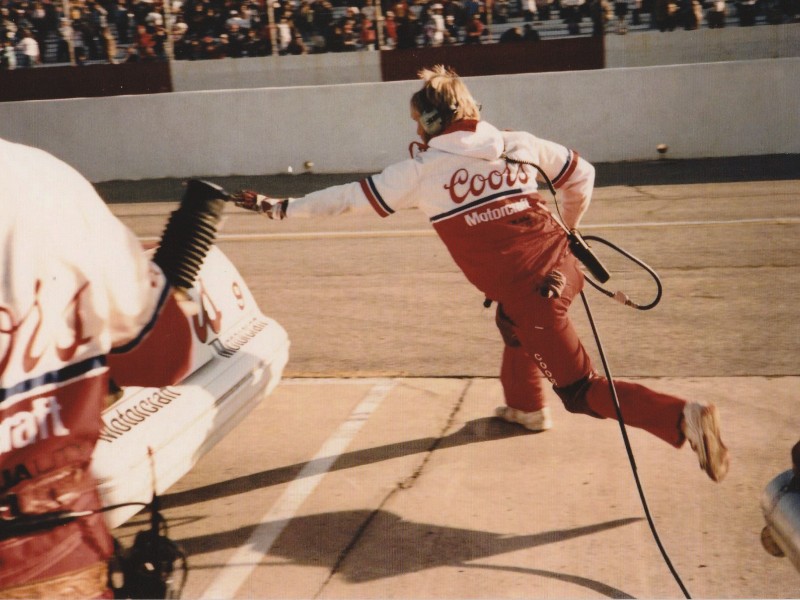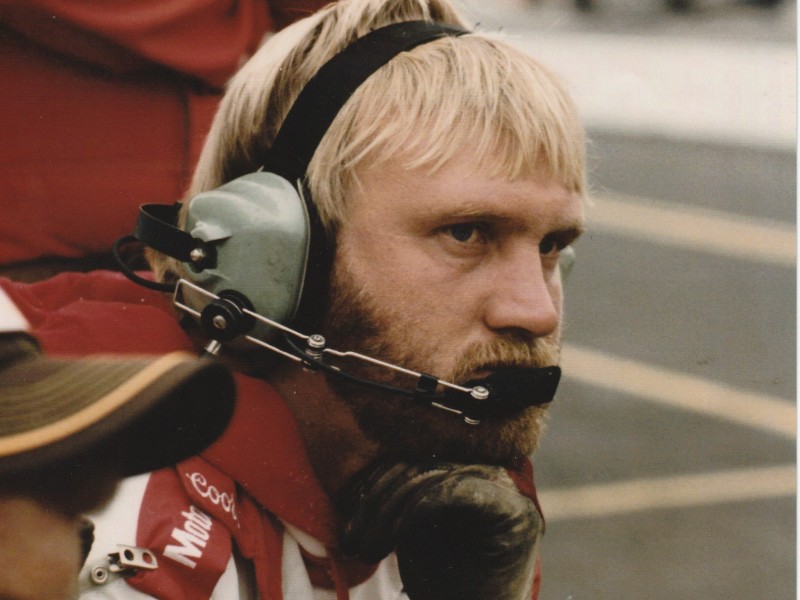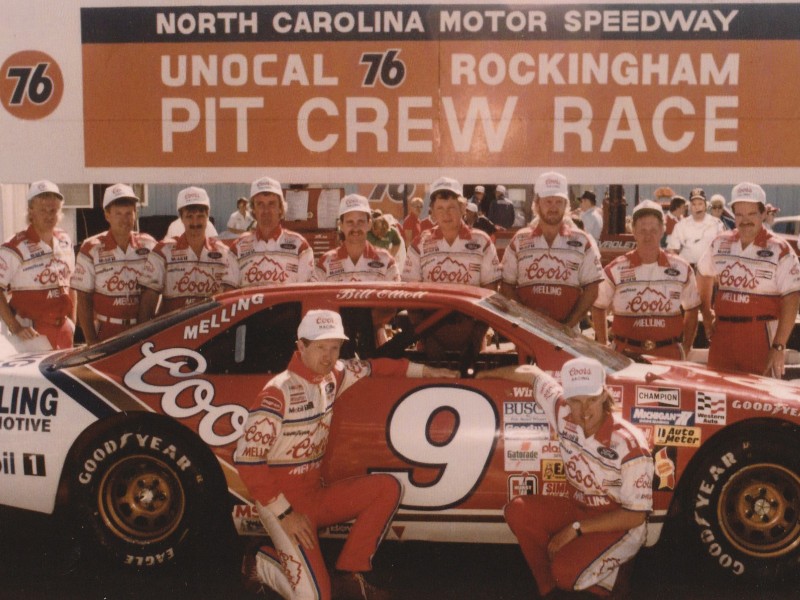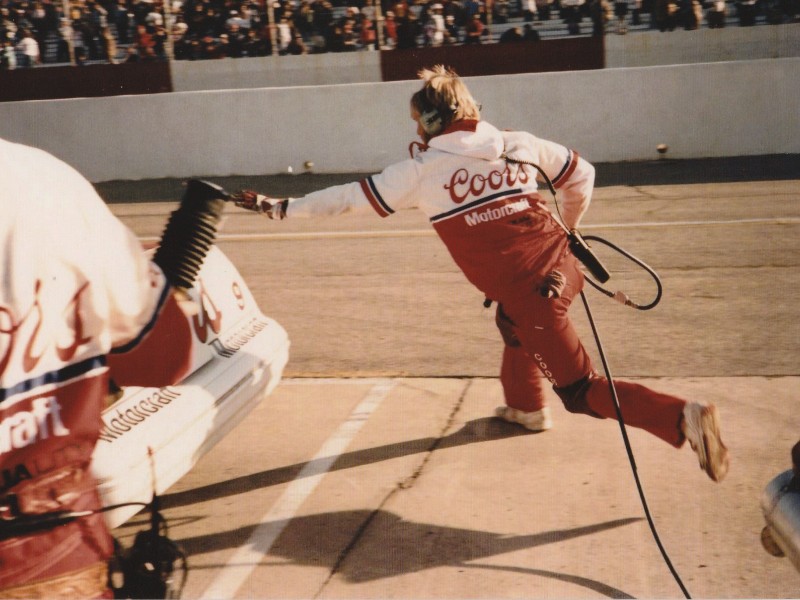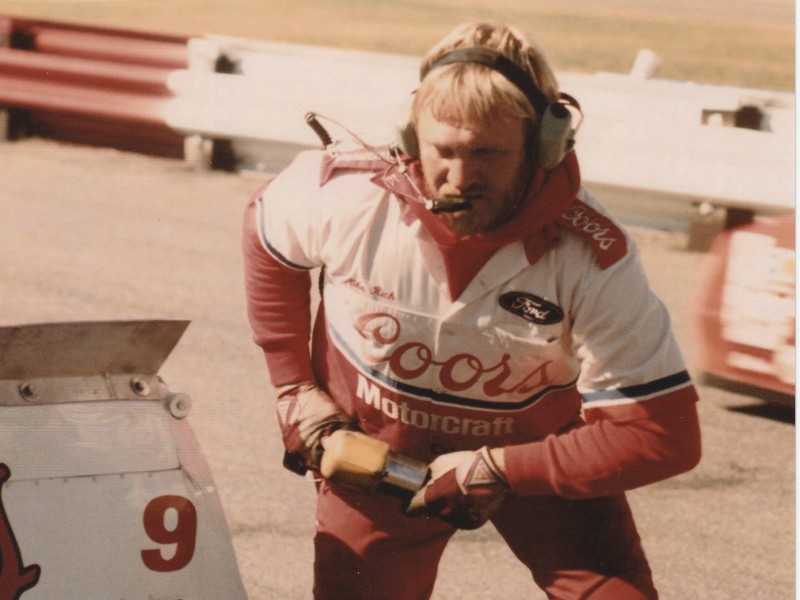While most people watching an automobile race would believe that the most dangerous place at a race track is out where the racing takes place, they would be wrong.
In their cars, the drivers are cocooned in safety gear, including a steel framed roll cage, seven point seatbelt harness, flame retardant racing suits and crash helmets, among others.
But on the most dangerous part of the track, the participants have little to protect them other than a helmet, uniform and their wits. That spot is pit road, where cars roar down for service during a race.
But it is better than it was in the past. For the majority of the history of motorsports around the world, drivers would charge down pit road at speed, taking advantage of the trip into and out of the pits to try to gain ground on competitors. Crew members had little to no safety equipment, with many doing their job of changing tires, making repairs and refueling the cars wearing a T-shirt, blue jeans and sneakers. As one may imagine, that made the crew members the most vulnerable people at the track.
Over the past 30 years, safety precautions have moved forward by light years. While pit road is – and always will be – inherently dangerous, the risk of injury has dropped immensely.
That can be traced back to a tragedy that took the life of a Georgia man who was a member of an award-winning pit crew on a November afternoon at Atlanta Motor Speedway.
Mike Rich, a native of Blairsville, Georgia, paid the ultimate price while changing the right rear tire on the No. 9 Melling Racing Ford.
On November 18, 1990, driver Bill Elliott had led 94 of the 328 laps that made up the Atlanta Journal 500, the most of any driver. He was in firm control of the race with just over 30 laps to go when the caution came out for a crash in the fourth turn. With the yellow flag flying, the field came down for what was expected to be their final pit stops of the day.
Elliott hit his pit stall on the nose, and his team – who weeks earlier had won the annual pit crew competition at Rockingham Speedway – leapt into action. Mike Rich rounded the back of the No. 9 Ford, dropped to his knees and went to work changing the right rear tire.
Behind him, Ricky Rudd was hustling his car down pit road, trying to get to his pit stall, located in front of Elliott’s, as fast as he could. As he tried to slow down, the rear wheels of his Chevrolet locked up under braking, sending his car spinning, out of control, toward Elliott’s stationary car.
Mike Rich was working with his air wrench to remove the lug nuts from the right rear wheel. He had his back to traffic. He never saw Rudd’s car coming.
Rudd’s out of control car spun backwards, slamming into the right rear of the No. 9 Ford, pinning Rich between the two cars. The team’s jack man, Tommy Cole, was also hit and sent flying. Cole suffered a broken arm, and spent a night in the hospital, but he would be okay.
Rich was severely injured, but was still alive. Safety and medical teams were on the scene within seconds. Rich was taken via air ambulance to Georgia Baptist Medical Center, where he underwent surgery for what was described as head and chest injuries.
Veteran motorsports journalist Rick Minter was covering the race that day for the Clayton News Daily. He was on the other end of pit road when the crash occurred, but his photographer, Andy Cash, was in the Melling team pit area when it happened.
"He told me how bad it was," Minter said. "I was just sick to my stomach. I didn’t really know Mike but I knew a lot of guys on that crew."
Both drivers continued on after the accident. Elliott would finish in 15th while Rudd finished 16th.
"Frankly I was hoping the two drivers involved would park their cars at that point, but in their defense they might not have known how bad it was," said Minter.
Rich hung on for a couple of hours, but he lost his fight for life around 8 o’clock that night. Mike Rich was dead at 32 years of age, leaving behind his wife, Teresa.
"In the years since I’ve felt bad for all involved,” Minter said. “It’s a terrible burden for them to bear."
Born on April 8, 1958, Rich was a fan of racing from early on. He gave up his spot on the high school’s basketball team for a chance to attend the Daytona 500 after the team’s coach refused to let him miss a game to go to the race.
Rich was a construction worker by trade, and had his own grading business by the time 1983 rolled around. Along the way, he married Teresa Kelley on March 20, 1982.
The entire time, his love for racing continued. He would travel to Daytona for SpeedWeeks, leading up to the Daytona 500 on several occasions. He also used his skills to help Georgia’s Sugar Creek Raceway, now known as Blue Ridge Motorsports Park, reopen by grading the clay at the 3/8-mile dirt track to get it back in race shape.
Rich was a member of the Jaycees in Blairsville for 10 years, and served as the group’s president in 1987.
In January of 1988, his life took a major turn toward the sport he loved, as he earned his spot on the Melling Racing team as the right rear changer.
And no other word describes it properly – he EARNED it.
In the next to last race of the 1987 season on the road course in Riverside, California, the Melling team was in the middle of a pit stop when the cars of Michael Waltrip and Jim Robinson made contact, sending Waltrip's car sliding into the Elliott car, knocking it off the jack. Three crew members, Chuck Hill, Steve Colwell and Butch Stevens, were injured, with Hill getting the worst of it. He suffered massive injuries after the car came down on him, and would spend weeks in a California hospital.
With the 1988 season opener on the horizon, the decision was made to hold a tryout day at the team's shops in Dawsonville, Georgia in January to find a new right rear tire changer to replace the injured Hill.
Local author Dave Wiley attended the 1988 team reunion, and talked to Rich's teammate Doug Shaak, who remembered the tryout day and how Rich earned his spot on the team.
"Since I changed the left side tires during pit stops, I decided I'd watch the tryouts to see who we'd have to replace Chuck," Shaak told Wiley in an interview. "The 'prospects' were all lined up against the wall across the garage, sort of looked like they were getting ready for a firing squad. I looked down the row, giving them the once over and you know what? The last joker was wearing cowboy boots for goodness sake.
“It was Mike Rich. And he got the job. Beat all the rest of them wearing cowboy boots."
The 1988 NASCAR Cup Series season got off to a fast start for the Melling team with Elliott behind the wheel, as the team scored their first win – and their first-ever short track victory – in the sixth race of the year at Bristol Motor Speedway.
The team would go on to score victories at Dover in June and Daytona in July, followed one week later by a win at Pocono. They would add wins in the Southern 500 at Darlington in September and an additional win at Dover in September to make it six trips overall for the year.
But the biggest prize waited at the end of the season, as an 11th-place finish in the season finale at Atlanta gave Elliott and the Melling Racing team their only series championship. Rich and his teammates sat at the head table in December as the championship winners at the NASCAR Awards Banquet at the Waldorf-Astoria in New York.
The team saw a setback to defending their title in 1989 when a practice crash at Daytona left Elliott with a broken wrist. Georgia Racing Hall of Fame driver Jody Ridley was called on to step in for the first two races of the season at Daytona and Rockingham. Elliott would start the race, with Ridley taking over during the first pit stop to allow the team to gain the championship points.
With Elliott back behind the wheel, the team worked to regain their winning form. The team would rebound to score three victories on the season, winning in June at Michigan, in July at Pocono and at Phoenix in November. They also won two poles and finished sixth in points.
The 1990 season had been a series of near misses for the Melling team, as they recorded 12 top five and 15 top ten finishes. But only one of those was a win, as the team won from the pole in the September race at Dover.
But the pit crew stepped up to a big challenge, as they won the prestigious UNOCAL Pit Crew Championship at Rockingham Speedway in October.
When the team rolled into Atlanta Motor Speedway a few weeks later for the NASCAR Cup Series season finale, they were focused on closing the year with a win on their home turf. After starting ninth, Elliott worked his way to the lead for the first time on lap 136, pacing the race for 63 laps. He would take the lead again on lap 240 for 24 circuits, and then took the lead for the final time on lap 293. The team appeared to have the win in hand when the final caution flew, bringing the field to pit road.
But fate took a hand, and tragedy followed.
The accident was eerily similar to one that occurred at Atlanta on March 18, 1979. In that event, rookie driver Dave Watson was leading when he came to pit road on lap 123. Watson was heading for his pit stall when the brakes locked on his car, sending it into a spin. The car struck his team’s jack man, 18-year-old Dennis Wade. Wade was sent flying about 100 feet down pit road.
The Charlotte, North Carolina high school student was pronounced dead upon arrival at an area hospital. It marked the first death on pit road in the track’s history.
Motorsports tends to be more reactive than proactive. While Wade’s unfortunate death did not result in changes to pit road, Rich’s would become a major influence in motorsports.
One reason was likely television coverage. The 1990 season finale was being carried live on ESPN, and, as the leader, the TV cameras were focused tightly on the No. 9 Ford when the accident occurred. The terrible footage would be carried and repeated on nightly newscasts throughout the country.
"Television has given the sport so much more exposure over the last 30 years than it got previously," said racing historian Mike Bell. "NASCAR does not like for negative stories about the sport to be shown to television viewers."
That drove home the point – something HAD to change.
And change it did. Going into the 1991 season, NASCAR began implementing a series of changes trying to find a fit that would not impede the overall competition. Series officials tried an even/odd pit schedule for the Daytona 500. Over the coming weeks, that would morph into an overall pit road speed limit, along with limits on what crew members could do.
"I had kinda helped out on a few pit stops in the past and I thought it was too dangerous the way they were pitting cars at that time," said Minter.
Every other major motorsports sanctioning body around the world followed suit, including Formula 1, IndyCar and IMSA. Eventually, even the weekly short tracks implemented pit road speed limits and more stringent rules for pit crews and for admission to the pits in general.
Now pit road safety is one of the most important aspects of racing for sanctioning bodies like NASCAR. Teams can’t go over the wall too early, must secure equipment, are required to wear helmets and other safety aspects that were unheard of just 30 years ago.
"At least NASCAR finally cut the speeds on pit road and adopted other safety measures," said Minter.
Rich’s death brought attention to the dangers of pit road, and now countless people can thank him for measures that have protected them and, in some cases, saved their lives.
Mike Rich has been nominated and is on the ballot for the Georgia Racing Hall of Fame. Thus far, he has yet to receive enough votes to enshrine him in the Hall. The Dawsonville, Georgia institution has honored many great and deserving drivers and competitors over the years, and even a few car owners and race track owners.
But its hallowed are woefully lacking when it comes to honoring mechanics and especially pit crew members, who put their lives on the line every time they step over the wall to service a race car.
“Have you ever changed a tire on the side of the expressway? They work under the same conditions,” said Bell. “Auto racing is now viewed as the team sport it always has been, just like stick and ball sports. Each person has a job. Maybe one is more important than the other, but each job has to be done correctly to give the team a chance to win.”
Wiley has worked tirelessly with many of the Rich’s Melling Racing teammates to get him nominated. They remain hopeful that he will be found worthy of induction sooner rather than later.
“No driver wins a race without their crew members,” said Wiley. “In Mike Rich we have a guy that worked as hard as he could to be the best tire changer in NASCAR. He choked back fear to jump that pit wall and do his job and he sacrificed his life for it. That's what a hero does.
“Mike Rich died a hero. And his death made the entire world of auto racing safer.”
After paying the ultimate price for the sport he loved, Mike Rich could be the first of many deserving pit crew members to be honored, and to be remembered not only for the loss of his life, but the preservation of so many others.


